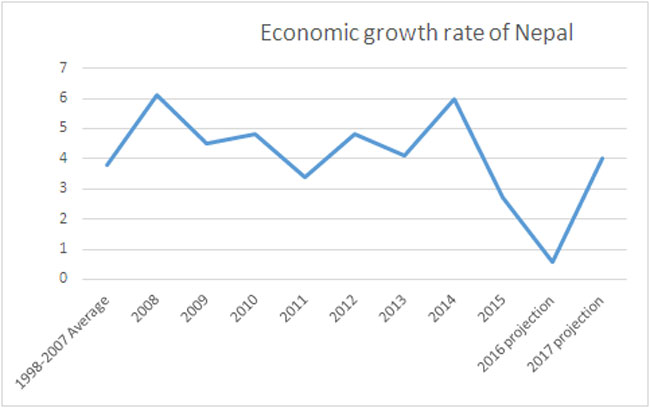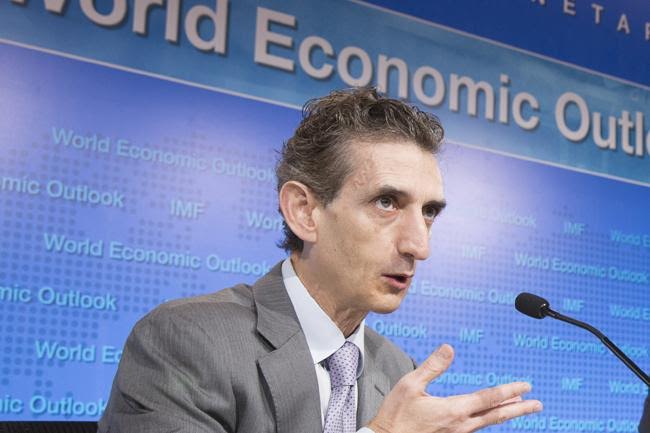World Bank puts growth projection for Nepal at 5 percent
WASHINGTON, DC, Oct 4: While the government says Nepal will achieve an economic growth of 6.5 percent in the current fiscal year, the International Monetary Fund on Tuesday projected that Nepal’s growth in the current fiscal year would rebound by only 4 percent.
Releasing the World Economic Outlook (WEO) on Tuesday in Washington, DC, amid a press meet, the fund made a forecast that Nepal’s gross domestic product (GDP) will rise by 4 percent in the current fiscal year.
IMF has further lowered the economic growth forecast by 0.5 percentage points to 4 percent. Earlier in April, the fund had said that Nepal’s growth would rebound by 4.5 percent in 2017. It had projected the economy to grow only by 0.5 percent in the Fiscal Year 2015/16.
According to Nepal Rastra Bank (NRB), Nepal saw an economic growth of 0.8 percent in the last fiscal year, experiencing its slowest growth in the last 14 years.
In April, IMF officials had said that they expected there was a good chance for growth to pick up once reconstruction started in earnest and border conditions normalized.
The devastating 2015 earthquakes and unofficial economic blockade imposed by India had pushed down Nepal’s economic growth by 0.8 percent in Fiscal Year 2015/16.
However, IMF’s downward revision of growth forecast comes at a time when reconstruction has failed to gather momentum as expected.
 Source: IMF, World Economic Outlook, October 2016
Source: IMF, World Economic Outlook, October 2016
“Weak capital spending, slowing remittances, political uncertainty and other number of head winds that we see in Nepal have led us for the conservative projections,” Gian Maria Milesi-Ferreti, a deputy director at the Research Department of IMF, said.
Meanwhile, the World Bank was a bit more optimistic about Nepal’s economic growth.
A separate report by the World Bank released on Tuesday projects an economic growth of 5 percent in the Fiscal Year 2016/17.
Why do the economic growth forecasts differ?

The World Bank has attributed improvement in the agriculture, construction and reconstruction to cause a rebound in the growth rate.
“Agriculture and construction are expected to improve on the account of a good monsoon as well as increased disbursements of housing reconstruction grants. Coupled with increased government spending, this is expected to push FY2017 growth to 5 percent and to remain in line with potential thereafter,” read the report entitled ‘Investment Reality Check’.
“The rebound in growth is on the back of a normal monsoon that will boost agricultural output and supported by increased investment (both public and private) as the political process stabilizes and earthquake recovery gathers speed. Manufacturing in particular is expected to get some boost starting from FY2017 with the apparels and garment industry getting a duty free access in the US market,” it added.
However, Nepal’s projected growth rate is far below the growth rate projected for the South Asia region. Led by solid performance in India, the economic growth is expected to gradually accelerate to 7.3 percent in 2017 from 7.1 percent in 2016, according to the World Bank report.
The World Bank forecast comes almost a fortnight after another multilateral development partner -- the Asian Development Bank -- estimated a growth of 4.8 percent for the current fiscal year.
Nepal has had a difficult year due to the earthquake, border disruptions with India, and reduced remittances, the World Bank noted.
“Its economic activity is recovering with growth expected to rebound to 5 percent in 2017, after a weak year 2016 at only 0.6 percent growth,” the World Bank report reads.
Likewise, the multilateral development partners also said that South Asia has defied a sluggish world economy and solidified its lead as the fastest growing region in the world in 2016.
According to the twice-a-year South Asia Economic Focus, the region remains a global growth hotspot and has proven resilient to external head winds such as China’s slowdown, uncertainty around stimulus policy in advanced economies, and slowing remittances. The main challenges remain domestic, and include policy uncertainty as well as fiscal and financial vulnerabilities.
“A reality check reveals that private investment -- a key future growth driver across South Asia -- is yet to be ignited to sustain and further increase economic growth,” said Annette Dixon, World Bank South Asia Region’s Vice President. “Countries will need to activate the full potential of private investment and exports to accelerate economic activity further, reduce poverty and boost prosperity.”
Given its weight in the region, India sets the pace for South Asia as a whole. Its economic activity is expected to accelerate to 7.7 percent in 2017, after maintaining a solid 7.6 percent in 2016. This performance is based on solid growth contributions from consumption -- boosted by normal monsoon and civil service pay revisions. Over the medium term, accelerated infrastructure spending and a better investment climate may help increase private investment and exports.
A reality check on the state of private investment in South Asia shows that the region has fallen short of expectations. Mobilizing domestic savings remains key at the aggregate level.
However, remittances and foreign direct investment prove very effective on a per-dollar basis, and the region should make the most of them.
India can further rely on public infrastructure to crowd-in private investment, while finance may constrain investment in Pakistan. The business cycle matters all across the region, providing a potential accelerator from GDP growth to investment growth. Ultimately, the investment climate sets the broader stage. “Alas, most South Asian economies suffer from a challenging business environment and some are subject to broader uncertainty and insecurity, which is detrimental to investor confidence,” it said.
“Political economy risks are widespread across South Asia, and uncertainty will need to be managed, particularly with a view to creating an attractive environment for domestic and foreign investment alike,” World Bank South Asia Region’s Chief Economist Martin Rama, said. “Delivering the necessary energy, infrastructure, and regulatory improvements remains critically important to increasing private investment, thus boosting job creation and reducing poverty.”
Releasing World Economic Outlook on Tuesday in Washington DC amid 2016 Annual Meetings of the International Monetary Fund and the World Bank Group, the IMF made downward revision of Nepal’s economic growth for 2017 by 0.5 percentage to 4 percent. Sagar Ghimire of Republica talked with Gian Maria Milesi-Ferretti, a deputy director at the Research Department of the IMF, in the sidelines of the annual meetings. Excerpts:
What are the reasons that the IMF decided to lower the projection of the growth rate for 2016/17 by 0.5 percentage despite expectation that the reconstruction activities would contribute to the growth?
The growth rate for 2015/16 ended up at 0.6 percent because of the trade disruption, weak monsoon and earthquakes. Monsoon this year was good so that encouraging for growth and the government is disbursing the first tranche of housing grant.
If we see the historic average of the growth of Nepal of 15 years prior to the earthquake, the average growth rate was around 4.3 percent. But as you said, there was expectation of growth going higher after the end of border disruption. But, there are still a number of domestic headwinds and uncertainties that we have taken in account for making conservative growth projection for the next year (2017). With the change in the government in August and turnaround in key spending ministries, the implementation of the budget and capital spending is slow, which implies a little bit less growth.
The data of the first two and half months of the capital spending is on the weak side. So, the weak capital spending will be a character holding back the growth.
There were changes in the management of Nepal Electricity Authority and that could imply some delays in the improvement of the availability of power. Also, there is the issue of remittances. What our team notes is that the number of workers going abroad for the employment was quite weaker in 2015/16 than it was in 2014/15. So, their concern was that the lower number implies weaker remittances. With weaker remittances, you get less spending. The last reason for the revision relates to the political uncertainty which remains on the high side. The issues of local elections as well as implementation of last year’s constitution are on discussion. Given that, you could have uncertainty and headwinds to economic activities. Those are the reasons for more conservative projection for economic growth of Nepal for next year.

Gian Maria Milesi-Ferretti
The earthquakes in 2015 are attributed to one of the slowest economic growth rates in the last fiscal year. How long it takes for the economy of any country that has suffered from natural disaster to rebound or get into the track of economic recovery?
It really depends on the extent of disruption and availability to get started on reconstruction efforts. In case like in an earthquake, it may take a while. You have two effects. One positive effect is that reconstruction activities that gets started to repair to damage contributes to the higher growth.The negative effect is that you get persistent disruption to production. You have facilities that are not usable for production anymore and that tends to weigh on growth.
It is hard to give a precise time that it takes for the recovery. But, it depends on difficulties on doing reconstruction activities, the extent of damages, the level of development of a country and access of financial resources of a country to do reconstruction activities.
You talked about slowing down remittances. How much impact can it make in the overall economy?
The impact of declining remittances could be negative. To the extent you receive less income from abroad, you will have less domestic spending. The decline in the spending could be in the same order in the decline in the magnitude of the remittances. There could be an argument that some remittances would be saved.
But, in a country with a lot of development needs, or with poverty, the propensity to consume out of income is likely to be high. If you lose, say 100 dollars in remittances, I would expect, spending to fall by very similar amount.




































